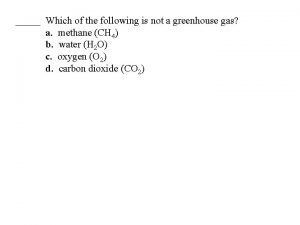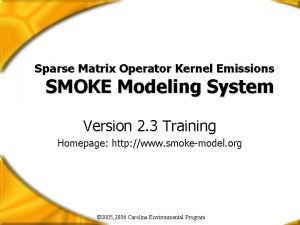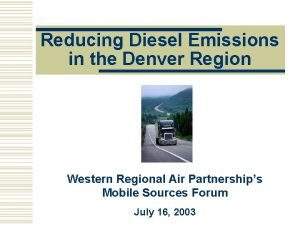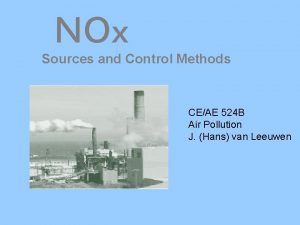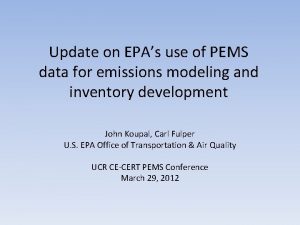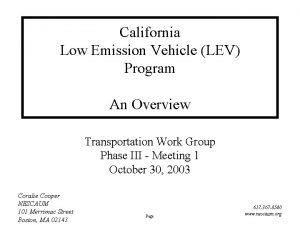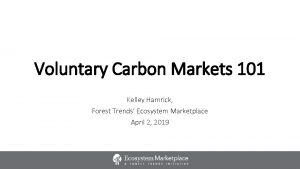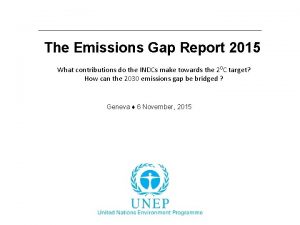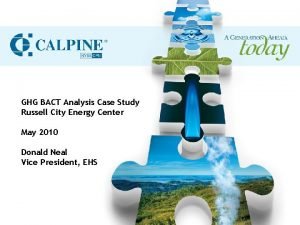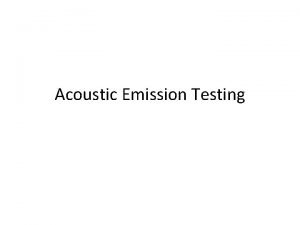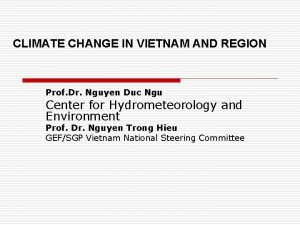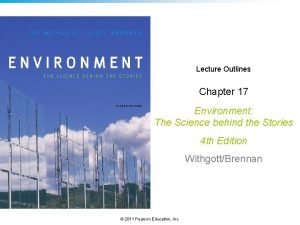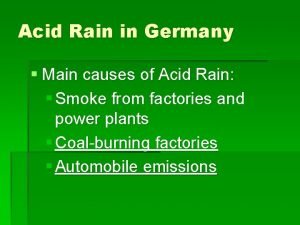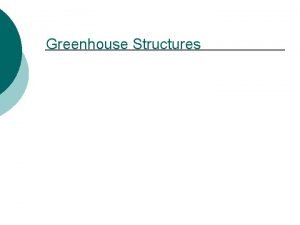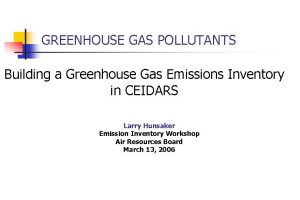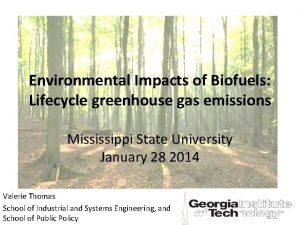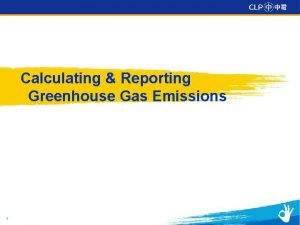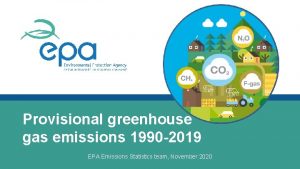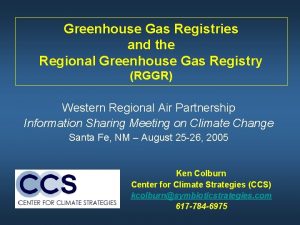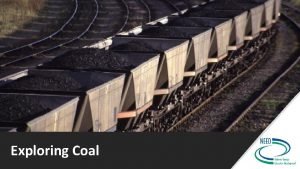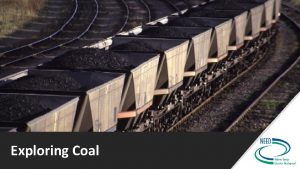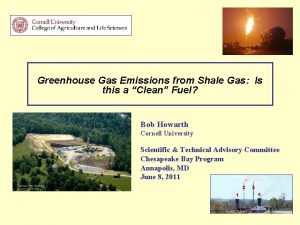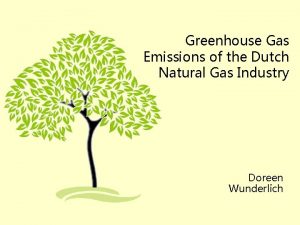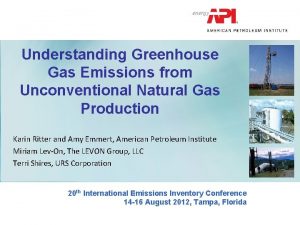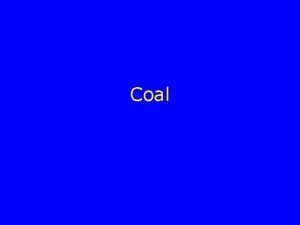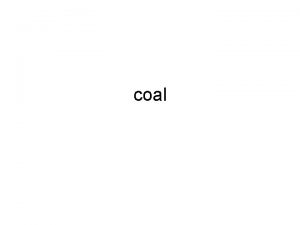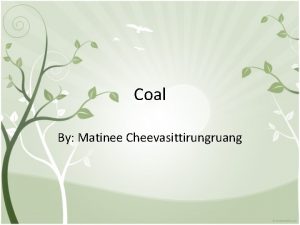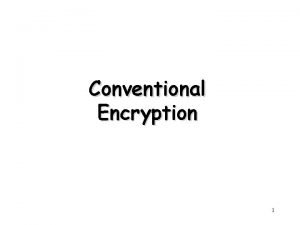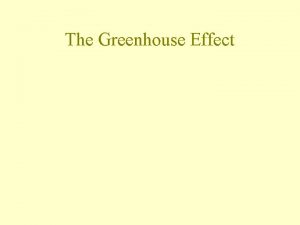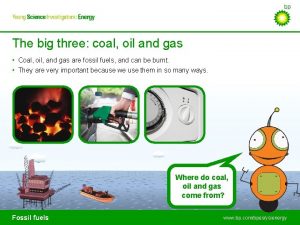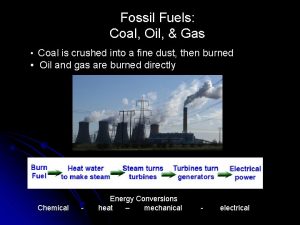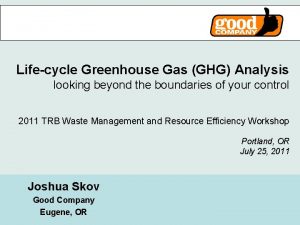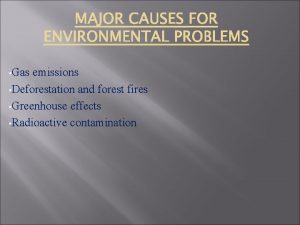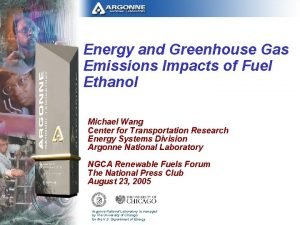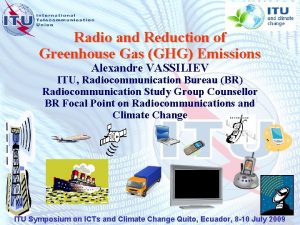Lifecycle greenhouse gas emissions of coal and conventional























- Slides: 23

Lifecycle greenhouse gas emissions of coal, and conventional and unconventional natural gas for electricity generation Ozge Kaplan, Ph. D and Andy Miller, Ph. D Photo image area measures 2” H x 6. 93” W and can be masked by a collage strip of one, two or three images. The photo image area is located 3. 19” from left and 3. 81” from top of page. Each image used in collage should be reduced or cropped to a maximum of 2” high, stroked with a 1. 5 pt white frame and positioned edge-to-edge with accompanying images. Office of Research and Development National Risk Management Research Laboratory 1 November 2012

Our motivation • Paper by Howarth et al. (2011) claimed that greenhouse gas (GHG) emissions from natural gas could be twice that of coal, mostly due to fugitive emissions from hydraulic fracturing • This assertion would significantly impact the strategies of using natural gas as • a replacement for coal in power production • a bridge fuel in a climate mitigation strategy, reducing emissions prior to full deployment of renewables • an alternative fuel in transportation • We initiated a study to evaluate those claims 1

Outline • Background information • Key issues to consider • LCI approach and boundaries • Results and discussion 2

Our findings • The GHG footprint of natural gas is not likely to be greater than that of coal • Fugitive emissions of natural gas from hydraulic fracturing are important, but not the only factor in full life cycle accounting • The high GWP of methane increases the GHG footprint of natural gas, but methane leakage can be more easily controlled than CO 2 from combustion • The higher efficiency of combined-cycle natural gas plants compared to coal plants diminishes the impact of leakage per unit of useful energy 3

Background • Natural gas is often regarded as a critical element in climate mitigation strategies because of its low CO 2 combustion emissions relative to coal • Gas-fired electricity production also has lower NOx, SO 2, and PM emissions than coal • The recent trend is towards replacement of the coal-fired utilities with natural gas combined-cycle units • Advancements in well drilling and extraction operations have provided new opportunities to extract natural gas from shale formations • The U. S. Department of Energy suggests that by 2035, 45% of the natural gas in the U. S. will be supplied from shale formations 4

Key issues to consider • The rate of natural gas leakage from hydraulic fracturing well completion • Of particular concern are emissions vented during flowback (reported values range from 0. 6% to 3. 2%) • Which global warming potential coefficient is used for methane • 100 -yr value is estimated to be 25 (times higher than CO 2) by IPCC; the 20 -yr value is estimated to be 72 • Howarth et al. used an increased value of 105 based on Shindell et al. (2009) • Selection of appropriate end use to compare • Many new baseload natural gas plants have considerably higher efficiency than coal plants 5

Approach • Evaluated the data presented in Howarth et al. (2011) • Extended and updated the analysis, based on review of published data from EPA, NREL, and other peer-reviewed sources on coal and natural gas from both conventional and shale formations • Compared CO 2, CH 4 and total GHG emissions from extraction, processing, transmission, storage and end use • Focused on natural gas used for electricity generation • Excluded distribution related emissions 6

Methodology and assumptions Emission factors for NG in CO 2 e is summation of • NG loss at extraction (i. e. , well completion, flowback), production, processing, storage, and transmission • CO 2 resulting from utilization of NG during processing phase including flaring operations • CO 2 associated with electricity consumed during various operations in the supply chain • CO 2 resulting from combustion of NG to generate electricity Methane content of NG • 78. 8% Emission factors for Coal in CO 2 e is summation of • CH 4 resulting from mining operations • CO 2 resulting from fuel usage during mining operations • CO 2 resulting from transportation of coal • CO 2 resulting from combustion of coal to generate electricity Power Plant Efficiencies (%) Fraction of Shale Gas Current Fleet New Units Future Fleet Coal 33 37 35 NG 41 51 44 • 2009 13% • 2035 45% 7

LCI boundaries – well to wire Production Processing/Storage Transmission Power Generation Fugitive emissions from well drilling, completions and workovers Emissions flared/vented from - glycol dehydrators - pneumatic devices Electricity used during operations CO 2 emissions from the power plant Natural gas use during operations Emissions flared/vented from condensate tanks Natural gas use during operations * Similar LCI boundaries are developed for coal as well. 8

Impact of GWP choices on LC emissions Depending on the choice of GWP for CH 4, the natural gas LC emissions could result in either 31% more or 40% less than coal LCI due to the high leakage rate of CH 4 GWP 100 -yr for CH 4 = 25 GWP 100 -yr for CH 4 = 33

Impact of electricity generation efficiency on LC emissions Conversion efficiency does matter. Increased efficiency reduces natural gas use, which reduces CH 4 leakage. GWP 100 for CH 4 = 25 ~41% 10

Impact of electricity generation efficiency on LC emissions Assuming new plant efficiencies (>41%), the worst-case is that natural gas has about the same GHG footprint as coal. GWP 20 for CH 4 = 72 ~11% 11

Impact of existing and future projected shale gas fraction on LC emissions (GWP 100 -yr for CH 4 = 25) Even as the share of unconventional natural gas increases, improvements in fugitive mitigation and conversion efficiency indicate that the natural gas GHG footprint will remain substantially lower than that of coal. 12

Our analysis is comparable with these recent studies Author Affiliation Conv. Gas Emission Factor (g CO 2 e/MJ) Shale Gas Emission Factor (g CO 2 e/MJ) Stephenson SHELL - 66 Burnham Argonne 70 - 80 68 - 75 Hultman U of MD 61 – 68 67 – 79 Jiang CMU Venkatesh CMU Howarth* Cornell Jaramillo* CMU 68 (63 – 75) 66 (61 – 72) 65 - 80 Notes Shale is 1. 8 -2. 4% more than conventional The factors for liquid unloading in conventional wells are estimated to be higher than shale completions and workovers LCI of Marcellus Shale Domestic natural gas average Focuses on shale gas Investigated only conventional gas 57 EPA* 59 Domestic natural gas average GAO* 68 Domestic natural gas average * Our analysis included these studies. 13

Discussion • Emissions data are sparse and uncertain • Tremendous need for improvement • Transmission, storage, and distribution account for significant amounts of leakage • 1. 4%-3. 6% of produced natural gas • A substantial opportunity exists for control of vented emissions during hydraulic fracturing or conventional well completion and workovers • Some estimates are as high as 90% recovery • Flaring can also reduce CH 4 emissions, but results in CO 2, PM and hazardous air pollutant emissions 14

Summary • The GHG footprint of natural gas is not likely to be greater than that of coal • Fugitive emissions of natural gas from hydraulic fracturing are important, but not the only factor in full life cycle • The high GWP of methane increases the GHG footprint of natural gas, but much of methane leakage can be much more easily controlled than CO 2 from combustion • The higher efficiency of combined cycle natural gas plants compared to coal plants diminishes the impact of leakage per unit of useful energy 15

Future directions • Fugitive natural gas emissions must be quantified properly in all parts of the supply chain to evaluate effectiveness of proposed climate mitigation strategies • Other life cycle environmental impacts are also crucial to good decision making, as highlighted by the concern over impacts to drinking water • The choice of global warming potential value is important to understand • Additional evaluation can help clarify the most relevant measures of concern (e. g. , rate of climate change and the effect on projected global average temperature) 16

Questions and comments Contact Info Ozge Kaplan. Ozge@epa. gov Andy Miller. Andy@epa. gov 17

Sources reviewed • Howarth, R. Santoro, et al. (2011). "Methane and the greenhouse-gas footprint of natural gas from shale formations. " Climatic • • • • • Change: 1 -12. Jaramillo, P. , W. M. Griffin, et al. (2007). "Comparative Life-Cycle Air Emissions of Coal, Domestic Natural Gas, LNG, and SNG for Electricity Generation. " Environ Sci Technol 41(17): 6290 -6296. NREL (2011). Natural gas, at extraction site, Data years 1997 -2001. U. S. LCI Database. Golden, CO: National Renewable Energy Laboratory. www. nrel. gov/lci (accessed May 1 st, 2011). EPA (2011). Inventory of U. S. Greenhouse Gas Emissions and Sinks: 1990 -2009. Washington, DC EPA (2010). GHG Emissions Reporting From the Petroleum and Natural Gas Industry; Background Technical Support Document. GAO (2010). Federal Oil and Gas Leases: Opportunities exist to capture vented and flared natural gas, which would increase royalty payments and reduce GHGs DOE/NETL (2010). Life Cycle Analysis: Natural Gas Combined Cycle (NGCC) Power Plant. Pittsburgh, PA DOE/NETL (2010). Life Cycle Analysis: Existing Pulverized Coal (EXPC) Power Plant. Pittsburgh, PA Advanced Resources International and ICF International (2008). Greenhouse Gas Life-Cycle Emissions Study: Fuel Life-Cycle of U. S. Natural Gas Supplies and International LNG, Sempra LNG. Hondo, H. (2005). "Life cycle GHG emission analysis of power generation systems: Japan case. " Energy 30: 2042 -2056. Spath, P. and M. Mann (2000). Life Cycle Assessment of a Natural Gas Combined-Cycle Power Generation System. Golden, CO, NREL Unnasch, S. , R. Wiesenberg, et al. (2009). Assessment of Direct and Indirect GHG Emissions Associated with Petroleum Fuels. Zhang, Y. , J. Mc. Kechnie, et al. (2009). "Life Cycle Emissions and Cost of Producing Electricity from Coal, Natural Gas, and Wood Pellets in Ontario, Canada. " Environ Sci Technol 44(1): 538 -544. Stephenson, T. ; Valle, J. E. ; Riera-Palou, X. , Modeling the Relative GHG Emissions of Conventional and Shale Gas Production. Environmental Science & Technology 2011, 45 (24), 10757 -10764. Burnham, A. ; Han, J. ; Clark, C. E. ; Wang, M. ; Dunn, J. B. ; Palou-Rivera, I. , Life-Cycle Greenhouse Gas Emissions of Shale Gas, Natural Gas, Coal, and Petroleum. Environmental Science & Technology 2011. Hultman, N. ; Rebois, D. ; Scholten, M. ; Ramig, C. , The greenhouse impact of unconventional gas for electricity generation. Environmental Research Letters 2011, 6 (4), 044008. Venkatesh, A. ; Jaramillo, P. ; Griffin, W. M. ; Matthews, H. S. , Uncertainty in Life Cycle Greenhouse Gas Emissions from United States Natural Gas End-Uses and its Effects on Policy. Environmental Science & Technology 2011, 45 (19), 8182 -8189. Jiang, M. ; Griffin, W. M. ; Hendrickson, C. ; Jaramillo, P. ; Van. Briesen, J. ; Venkatesh, A. , Life cycle greenhouse gas emissions of Marcellus shale gas. Environmental Research Letters 2011, 6 (3), 034014. 18

EXTRAS 19

Summary of NG loss rates Conventional Gas Conv. + Shale Gas Howarth Low High Jaramillo NREL* EPA GAO Extraction/Production 0. 38% 1. 56% 0. 70% 1. 84% 2. 23% 4. 09% Processing 0. 16% 0. 27% 0. 00% 0. 19% Transmission and storage 0. 53% 1. 72% 0. 84% 2. 16% Total NG Loss/Vented 1. 07% 1. 39% 3. 83% 3. 07% 6. 44% 1. 56% *NREL reports only the NG loss during extraction, production and processing. 20

21

22
 Which of the following is not a greenhouse gas?
Which of the following is not a greenhouse gas? Nspe code of ethics quiz
Nspe code of ethics quiz Sparse matrix operator kernel emissions
Sparse matrix operator kernel emissions Diesel emissions denver
Diesel emissions denver Sources of nox emissions
Sources of nox emissions Parts of sperm cell
Parts of sperm cell Pems emissions modeling
Pems emissions modeling Where else have you observed colorful light emissions
Where else have you observed colorful light emissions Lev 2 emissions
Lev 2 emissions Voluntary carbon market
Voluntary carbon market Un emissions gap report
Un emissions gap report Luke autbeloe drops an approximately
Luke autbeloe drops an approximately Using citys heat reduce emissions
Using citys heat reduce emissions Application of acoustic emission testing
Application of acoustic emission testing Ghs emissions
Ghs emissions Splonc
Splonc Acid rain in germany
Acid rain in germany Achronims
Achronims Differences between ideal gas and real gas
Differences between ideal gas and real gas Difference between ideal gas and real gas
Difference between ideal gas and real gas Thank you
Thank you Lath house greenhouse advantages and disadvantages
Lath house greenhouse advantages and disadvantages Gothic arch greenhouse disadvantages
Gothic arch greenhouse disadvantages Pros and cons of greenhouse farming
Pros and cons of greenhouse farming
